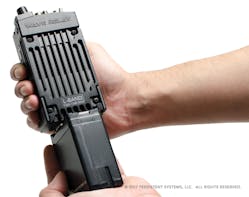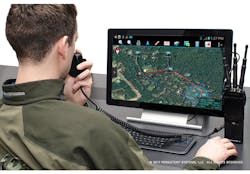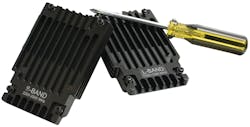Download this article as a .PDF
Tactical radios require tremendous capabilities and flexibility to remain effective on the battlefield. Most tactical environments consist of mobile ad hoc networks (MANETs) which must be interoperable with many different radio systems and organizations. The MPU5 from Persistent Systems is a smart radio designed to adapt to the changing conditions of the battlefield. Based on software-defined-radio (SDR) technology and the company’s own Wave Relay transmission algorithms, this is a tactical radio that also contains a full-featured computer for extensive functionality and advanced mobile networking.
The smart radio (Fig. 1) is equivalent to portable computer server that fits in the palm of the hand, with enormous computing and networking capabilities. The processing power that drives the MPU5 is Android-based, with 1-GHz quad-core ARM, 2 GB RAM, and 128 GB of flash memory storage. Users can run Android Tactical Assault Kit (ATAK) software and other programs and to record and review video footage, enhancing situational awareness and increasing operational effectiveness (Fig. 2). The MPU5 was a recent first choice for in-the-field networking by the FBI.
The MPU5 operates with interchangeable RF front-end modules, providing an operator with a choice of three different frequency bands, depending on module: L-band, S-band, and C-band frequencies. The miniature modules (Fig. 3), which provide as much as 6 W transmit power across each of its three frequency bands, can be swapped in the field for ease of changing operating frequency bands.
With its Cloud Relay networking capability, this compact smart radio can establish a peer-to-peer mobile network anywhere and is designed for mass scalability. Thanks to a flexible radio architecture that supports 3 × 3 multiple-input, multiple-output (MIMO) communications, it is capable of better than 100 Mb/s data throughput. It has a built-in high-definition (HD) video encoder/decoder for distributing real-time HD video feeds, along with an integrated GPS receiver with 1-s updates to provide full geographic situational awareness.
As noted above, the MPU5 operates with one of three interchangeable frequency modules, including the RF-1100 with L-band frequency range of 1,350 to 1,390 MHz; the RF-2100 with S-band frequency range of 2,200 to 2,500 MHz; and the RF-4100 with lower C-band frequency range of 4,435 to 4,980 MHz. All modules provide 6 W transmit power and software configurable bandwidths of 5, 10, and 20 MHz. All support transmit/receive operating modes from single-input, single-output (SISO) to 3 × 3 MIMO.
The MPU5 has an advanced audio architecture with 16 channels of PTT audio and radio over IP (RoIP) capability so that legacy narrowband radios can be tethered to the MPU5 and included in a MANET. To ensure networking security, the radio is equipped with CTR-AES-256 encryption, HMAC-SHA-256 authentication and integrity, and cryptographically authenticated over-the-air rekey and key-zero security.
The radio includes USB host and RS-232 serial ports, Ethernet, and USB-on-the-Go connections. It is also well equipped with power pack charging options, including an end-user-device (EUD) data/charging port, a charging downstream port (CDP) port rated for 1500 mA, and a standard charging port (SDP) rated for 500 mA. The power ports feature low-battery alert warning light.
The MPU5 Smart Radio is powered by 8 to 28 V dc, using a three-pin Fly Wheel Twist Lock connector (as used on AN/PRC-148 and AN/PRC-152 equipment). The radio is MIL-STD certified and built in an ISO 9001:2008 certified manufacturing facility. It has an operating temperature range of −40 to +85ºC.
When it is necessary to incorporate this kind of networking functionality and capability within another system, the company also offers its Embedded Module (Fig. 4) which includes much of the performance provided in the MPU5 but in a more compact modular package and without the operating controls. Optimized for size, weight, and power (SWaP), the Embedded Module is well suited for interconnecting unmanned aerial vehicles (UAVs) and unmanned ground vehicles (UGVs) in the field.
The Embedded Module shares many of the traits of the MPU5, with an HD video encoder and Android-based computer onboard. The module measures just 2.00 × 3.29 × 0.59 in. and weighs just 3.2 oz. The computer has a 1-GHz quad-core ARM, 2 GB RAM, and 128 GB of flash storage. The embedded module operates from voltages of 8 to 30 V dc and draws 0.3 A at 12 V dc. The embedded module also uses interchangeable frequency modules to switch operating frequency bands, and is screened to MIL-STD-810G for vibration, altitude, and temperature, with an operating temperature range of −40 to +85ºC.
Persistent Systems, LLC, 303 Fifth Ave., Ste. 306, New York, NY 10016; (212) 561-5895





